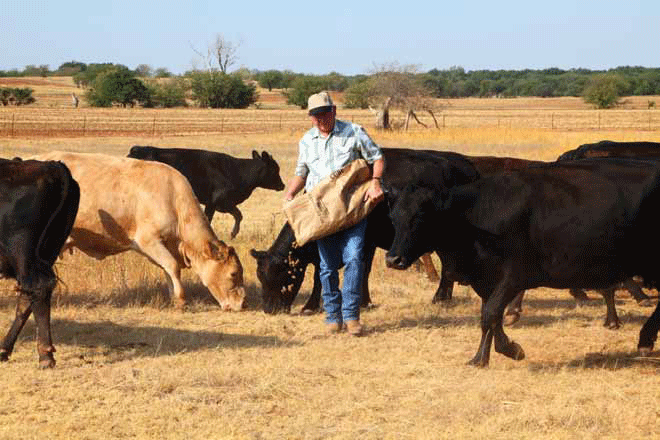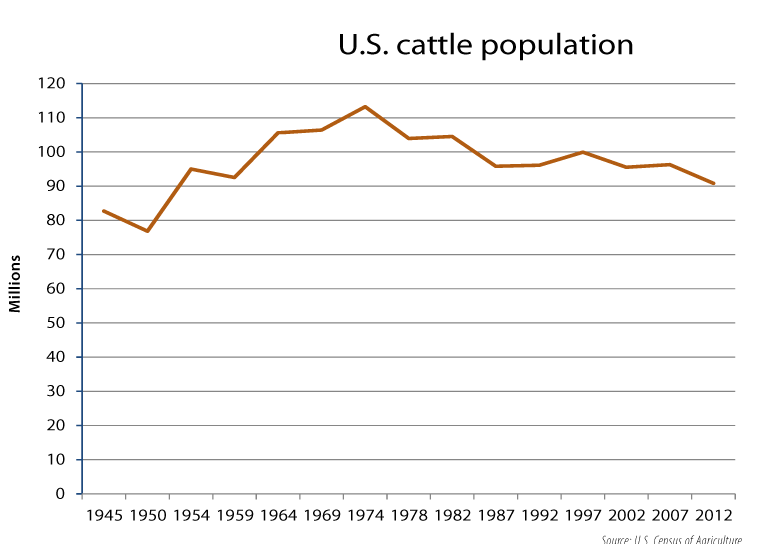Livestock numbers, services cut
Dr. Joe M. Hillhouse of Panhandle, Texas, said that during 2011 the cattle herds in his area were largely wiped out, and that the area has been enduring extreme drought since December 2010.
His clients’ cattle populations are about 25 percent of their normal numbers, and calls have almost disappeared.
“We have not done a significant cow business for a year now,” Dr. Hillhouse said.

Even the small animal side of his business was hurt by the drought as flea and tick populations declined with other insect populations.
Producers in the northern tip of Texas began selling increased numbers of cattle in spring 2011, and Dr. Hillhouse’s two largest clients shipped all 5,000 of their cattle far north by August 2011. He expects the cattle business eventually will return, since those clients had large operations following the consolidation that occurred in the cow-calf business over the past 10 years. Most smaller producers disappeared prior to the extended drought, he said.
“The fear I have for my colleagues, the ones who depend on smaller producers, is they may never see those clients come back,” Dr. Hillhouse said.
Dr. Brian J. Gerloff, 2011-2012 president of the American Association of Bovine Practitioners, said skyrocketing feed costs that squeeze producers have indirectly affected veterinarians. Greater numbers of ill cattle are culled rather than treated as production costs increase. He suspects producers are more likely to choose culling in western areas that are dealing with more intense drought conditions than are producers in his area, just south of the Illinois-Wisconsin border.
Consecutive years of drought have led livestock owners—particularly those who raise cattle—to send more of their animals to slaughter. The dry, hot weather of June and July and the resulting high feed costs also may have added to a nearly two decades–long decline in the size of the nation’s cattle herd.
Kenneth H. Mathews, PhD, an agricultural economist for the Department of Agriculture’s Economic Research Service, said beef cow slaughter was higher this year than it would have been without the drought, and cattle slaughter had risen even higher during the drought in 2011. Last year’s liquidation involved herds in Southern states, while this year, producers in states such as Missouri have sent increased numbers of cows to slaughter.
Dr. William R. DuBois, a food animal veterinarian in Oklahoma and a district director for the American Association of Swine Veterinarians, said pigs raised near him are kept in large, climate-controlled barns and were shielded from the effects of this past summer’s weather. But he said those farm owners still are affected by the damage to crops such as corn grown in drought-hit Iowa, Illinois, and Nebraska.
“All livestock industries will be significantly affected because of the impact it’ll have on corn,” he said.
Feed loss hurts herd size
An August report from the Economic Research Service states that, despite expectations that the cattle herd would expand this year, the beef replacement heifer inventories remained level, and dairy replacements had declined about 2 percent by July, largely because of depressed milk prices and increased feed costs. The report noted that ongoing drought since July could have caused further declines. In 2011, drought likely led producers to cancel plans for herd expansion in the South.
The persistent drought and the resulting high feed costs also are expected to decrease pork production by about 1 percent during 2013, as fewer pigs are farrowed from a reduced breeding herd and slaughter weights decline. In mid-August, R.C. Hunt, president of the National Pork Producers Council, said in a press release that pork producers faced severe losses because of record-high feed prices.

Dr. M. Gatz Riddell, executive vice president of the AABP, said some cattle owners are running short of pasture forage that would be available in a nondrought year, forcing them to feed hay or other forage that normally would be reserved for winter. The same owners may have to buy hay or other feed at higher prices later this year or sell cows for slaughter rather than keep them to breed. Replacing cows and rebuilding a herd could be prohibitively expensive during 2013, because the nation’s total cattle herd is shrinking.
The U.S. has about 91 million cattle, its smallest inventory since the early 1950s, according to figures from the USDA and U.S. Census of Agriculture. Past censuses state that the U.S. had about 77 million cattle in 1950 and 95 million in 1954.
The National Cattlemen’s Beef Association announced July 27 that the U.S. had 800,000 fewer calves than it did in 2011, when the population declined by 900,000.
Crop, pasture damage widespread
By Aug. 13, the Department of Agriculture had declared about 1,500 counties throughout the U.S. to be disaster areas because of drought during the 2012 crop year. About one week earlier, the USDA National Agricultural Statistics Service had reported that 60 percent of the country’s pastures and ranges were considered to be in poor or very poor condition.
Most of the nation’s corn, soybean, and hay is grown in areas that experienced extreme drought during summer 2012, according to the National Drought Mitigation Center’s U.S. Drought Monitor. Feed corn cost about 16 percent more than it did one year earlier. Hay cost 8 percent more, and soybeans were up 18 percent. Sorghum prices rose 15 percent.
Dr. Gerloff said the drought offers veterinarians some options if they are involved in nutrition work, because producers need good advice on how to manage a changing feed landscape and evaluate substitutes for traditional feeds.
In addition to paying increased crop prices, livestock owners receive less income for each animal when nationwide increases in culling put more meat on the market. For example, calves placed on feedlots in July, many of them younger and lighter than usual, were sold at prices sometimes one-fifth lower than they would have been in the spring, according to the Economic Research Service.
The ERS also expects that U.S. consumers will consume about a mean 2.5 percent less meat in 2013 than they did in 2012, dropping to a yearly total of less than 200 pounds of meat per person for the first time since 1990.
The drought is the worst Dr. Hillhouse has seen, but he said in early September that his area of Texas had received about 1 1/2 inches of rain in the previous two weeks, and the grass was its greenest in two years. He said he was actually glad to see bugs on his windshield again.